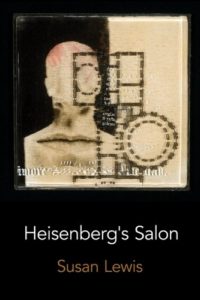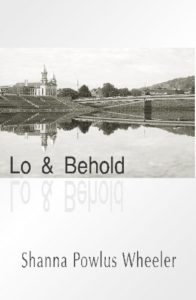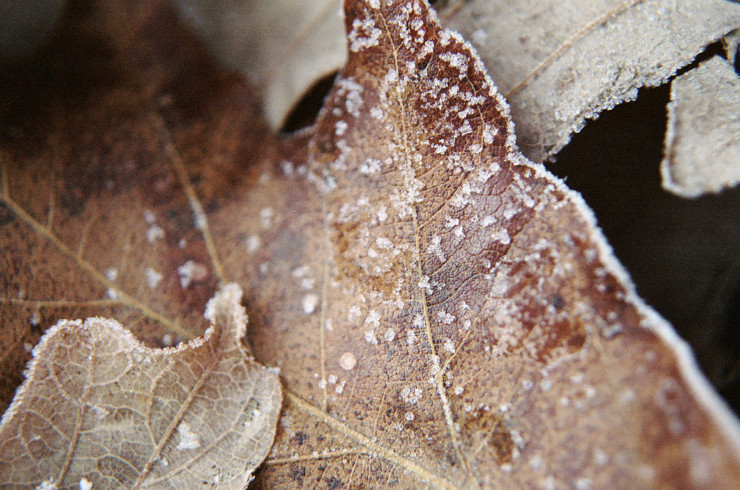In Heisenberg’s Salon, poet Susan Lewis draws inspiration from a principle of quantum mechanics. In 1925, physicist Werner Heisenberg (1901-1976) published what is known as his uncertainty principle—that in any system, you can’t know a particle’s exact location and exact velocity simultaneously. You can exactly know one or the other, but not both at the same time.
This idea of uncertainty is what Lewis develops in 54 prose poems—but not applied to quantum mechanics. Instead, she considers uncertainty in relationships, in human actions, in human thought, in our perceptions, and in how we understand the world. Here’s one example:
Indeterminacy

her imagine what. So she assumed her post on the stoop & waited
for the future to declare itself. A tattered bird of dubious
provenance landed on the banister & inspected her with his
ancient gaze. She exhaled with emphasis, but otherwise managed
to keep her preconceptions to herself. The old fellow cocked his
head & screeched. Terrific, she said. How am I supposed to know if
you’re the one I’m waiting for? Terrific, he squawked. How am I supposed
to know if you’re the one I’m waiting for? I get it, she said, bravely
extending her arm. I get it, he echoed, latching on with admirable
decision. It was the last conversation they ever had.
The use of the prose poem form is intriguing. Visually, a paragraph looks more definitive, and more substantive, than a series of lines arranged in the familiar verse form. It implies solidity, definition, fact. Yet Lewis turns the form on its head by the substance of each poem, taking us not to answers but to questions.

Susan Lewis
In the poem above, the speaker knows it’s time for something, and the arrival of a “tattered bird of dubious provenance” might have the answer, or might be the answer. The bird merely repeats what the speaker says, and “it was the last conversation they ever had.” It was also the first conversation they ever had. The conversation doesn’t come to a point—and that, perhaps, is the point. The uncertainty of the speaker is never defined or identified.
Lewis is the editor of the literary journal Posit. She received her MFA degree in creative writing from Sarah Lawrence University, and her BA and JD degrees from University of California-Berkeley. In addition to her several published books of poetry, she writes flash fiction, which has been performed on stage in Denver, and compositions with other artists performed at the Kennedy Center and Carnegie’s Weill Recital Hall. She lives in New York City.
Heisenberg’s Salon is one of the most innovative collections I’ve read.
Lo & Behold is a chapbook of 21 poems by poet Shanna Powlus Wheeler. The poems are drawn from geography, nature, memory, childhood, and other sources, and they are each a small gem, polished and shining, reflecting light and understanding. This poem is one example of how Wheeler combines childhood, memory, and understanding of who she is and where she came from, in addition to her relationship with her mother. We’re familiar with the children’s game of jacks, but this poem elevates the game to a new level of meaning.
Jacks

young as she, seven or eight, spindly,
kneeling on linoleum under dim, orange light.
Between our knob-knees bings the rubber ball;
the jacks chink in quick fists. First to gather all
ten without a double bounce or mishap;
my mother wins. Always said she was good at jacks,
I think. I watch her darker hair willow down long
beside mine; see freckles shift with a smirk;
hear her hand clasp jacks: a fist full of molecules like God’s.
This tiny jingle of jacks is the jumbled song of me.
In dreams I meet the girl not yet dreaming of me.

Shanna Powlus Wheeler
In a sense, this is an example, to borrow from William Wordsworth, of how the child is mother of the woman and mother to the woman. She imagines a game of jacks with her mother as a young girl. It’s competitive; one can almost hear the mother gloating with her “Always said she was good at jacks.” In this simple game comes an understanding of where the daughter will come from.
Wheeler studied poetry at Penn State University, where she received her MFA degree in 2007. Her poems have been published in such literary journals as North American Review, Evansville Review, and Ruminate. She directs the Writing Center at Lycoming College and lives in nearby Williamsport, Pennsylvania.
Lo & Behold is a short collection of poetry (the definition of a chapbook), but it is also a meditation, a reflection, and perhaps even a psalm.
Related:
Tweetspeak Poetry’s review of How to Be Another, State of the Union, and This Visit by Susan Lewis.
Photo by James Jordan, Creative Commons, via Flickr. Post by Glynn Young, author of the novels Dancing Priest and A Light Shining, and Poetry at Work.
__________________________

“I require all our incoming poetry students—in the MFA I direct—to buy and read this book.”
—Jeanetta Calhoun Mish
- Poets and Poems: Donna Vorreyer and “Unrivered” - October 7, 2025
- Poet Sidney Lanier and the Lost Cause - October 2, 2025
- Poets and Poems: A.J. Thibault and “We Lack a Word” - September 30, 2025

Mary Harwell Sayler says
Refreshing! Thanks, Glynn, for introducing us to poets inspired by the unobvious, waiting to be discovered around us all.
Glynn says
Mary – thanks for the comment. I’m always amazing at the process of inspiration.
Bethany Rohde says
Fascinating to read Susan Lewis’ poetry inspired by concepts of quantum mechanics. That juxtaposition of “bravely extending her arm” and “latching on with admirable decision” with then never speaking again is intriguing.
I see what you mean about Wordsworth’s idea fleshed out in Shanna Powlus Wheeler’s featured poem. I love the concrete details in:
“I watch her darker hair willow down long
beside mine; see freckles shift with a smirk;”
She beautifully captures a glimpse of her mother as the girl kneeling next to her. I’m going to check out her book now.
Rick Maxson says
It is interesting that you review these two books together. Whenever I think of Heisenberg, I am reminded of Erwin Schrodinger, both involved with the uncertainty as to how we observe the quantum and physical world. The famous Schrodinger’s cat experiment demonstrated how simultaneous and opposite states of matter exist until we observe one or the other. Applying Heisenberg’s uncertainty to how we humans go about what we think and do is fascinating.
“This tiny jingle of jacks is the jumbled song of me./ In dreams I meet the girl not yet dreaming of me.” is a marvelous ending to Wheeler’s poem imagining playing with her mother of the same age, knowing and not knowing how each was and would be. Jacks is the perfect game of life, accumulating the pieces that make up a life and managing them, while watching the position and speed of a bouncing ball.
Both of these books may go well with the upcoming book club reading Ian Leslie’s “Curiosity.” The world is so weird that we will never “figure it out.” We should all be glad of that.
I am familiar with both poets’ work, but neither of these books. I will be getting both. Thanks, again, Glynn.
Glynn says
Richard – I just finished reading two others – one by Daniel Borzutzky (The Performance of Being Human) and “performance poet” Kate Tempest (Let Them Eat Chaos) — that are causing me to pick up what’s left of my brain after it fell out on the floor. Two very different poets, different nationalities (American and British), but the same jarring, dislocating effect.
Rick Maxson says
Thanks. I’ll look them up as well. I’m “retired” from HP since 1/27, so I have time to fill.
Rick Maxson says
Glynn, I ordered Borzutzky and Tempest (what an auspicious name for a performance artist). Following information on Tempest I found a performance of Let Them Eat Chaos sponsored by the BBC. When you have 50 minutes or so, you might enjoy seeing it in action.
Shanna Powlus Wheeler says
Richard, your analysis of my poem “Jacks” thrills my heart. You pull out truths I myself couldn’t fully understand 10+ years ago when I wrote the poem. I now have my own daughter to play jacks with. And in all her spunk and spirit, she embodies that bouncing ball I must always keep my eyes on! Thank you.
Rick Maxson says
I just realized Leslie’s book is “Curious” not Curiosity. It could have been either until he chose to call it “Curious.” 🙂
Rick Maxson says
Glynn, I didn’t know this would put the video itself on the reply. Please remove it if you want to.
Shanna Powlus Wheeler says
Glynn, what a delight to read this thoughtful profile of my chapbook. Thanks so much for your support!